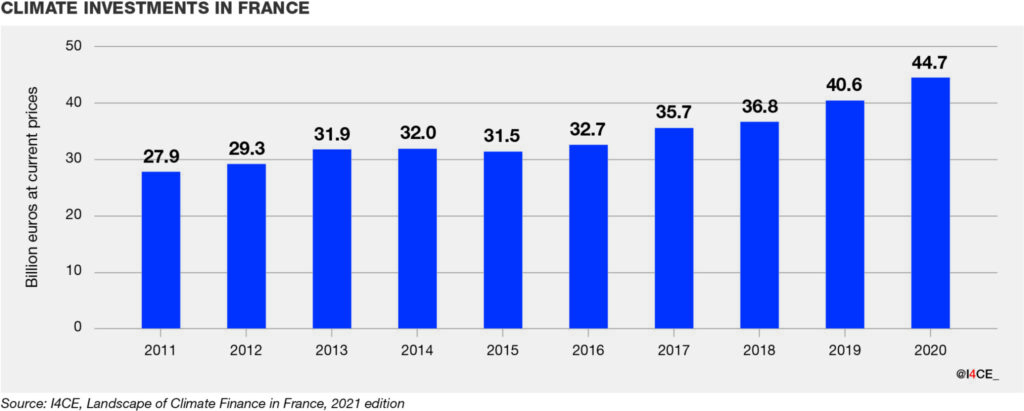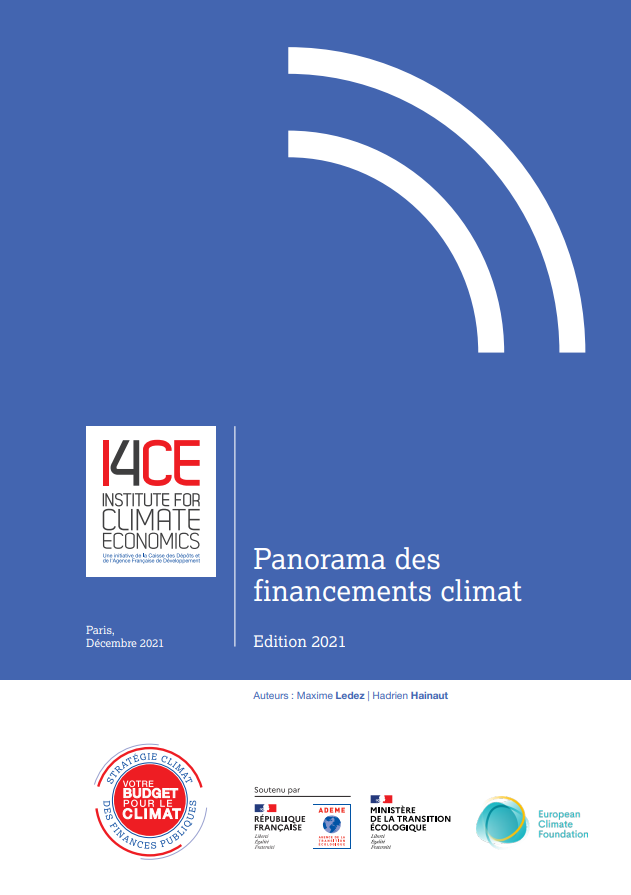Landscape of Climate Finance in France – 2021 edition
A steep rise in investment in low-carbon vehicles and sustained climate investment in other sectors, a fall in the financing of fossil fuels, a climate funding deficit of over 13 billion that recovery measures are unlikely to offset… These are some of the facts provided in the 2021 Landscape, in which I4CE also calls on public authorities to prepare for the end of the recovery plan.
(Report only available in French)
Despite the ongoing health crisis, public action has enabled the maintenance of climate investment in France. Although the economic recovery should see a boost to these investments in 2021 and 2022, the gap with respect to national objectives will nevertheless remain.
Climate investment maintained overall
In 2020, households, companies and public administrations invested 45 billion euros in climate-friendly projects. While climate investment in France increased by 10% compared to 2019, this was not the case in all sectors. The increase has been concentrated in electric cars and plug-in hybrids, while the financing of energy-efficient housing renovation, the rail network, public transport and renewable energy production have remained stable. Thus, climate investments have held up rather well: their increase contrasts with the sharp decline in total investments in the country during 2020 (a fall of 7.8%, according to INSEE).

The year 2020 got off to a bad start: the first lockdown interrupted construction, infrastructure and energy production projects, while health restrictions threatened the incomes of project developers. For example, public transport operators sold fewer tickets and passes, energy companies saw electricity prices fall, and the economic downturn threatened the income of many households. Under these conditions, project developers could have been forced to reduce their climate investments.
Emergency government measures, such as compensating for a reduction in working hours, state-guaranteed loans and lost income support for transport operators and local authorities, enabled project developers to retain sufficient resources to invest. And most households and businesses, believing that the economic slowdown would be temporary, maintained their investment plans.
An investment deficit that recovery measures are unlikely to offset
Despite having withstood the health crisis, climate investment remains insufficient to meet national targets by the end of 2020. An additional 13 to 15 billion in public and private investments are needed each year until 2023, with about double that amount required until 2028. This is a minimum target, as many sectors, such as agriculture, industry and nuclear power are not covered, and the new European objective implies more rapid action by 2030 to reduce GHG emissions by 55% compared to 1990 levels (currently at 40%).
Click on this button to see the image
Climate investment, supported particularly by recovery plan measures, is likely to continue to increase in 2021 and 2022, but will not make up the deficit. Indeed, based on the first available indicators, many requirements remain, particularly in relation to renewable electricity production, commercial vehicles and cycle paths. And while households are carrying out more energy-efficiency improvements in their homes, few are undertaking comprehensive, high-performance renovations as recommended by the National Low Carbon Strategy.
To fill the investment gap, an increase in public funding seems essential, in addition to regulations and support for project developers. However, the main climate financing of the recovery plan will end in 2022. It is in the interests of public authorities to anticipate the post-recovery period by drawing up a “public finance climate strategy” without delay.
Caution needed in light of new tensions and the risk of a rebound in fossil fuel investment
During 2021, certain commodities and equipment needed for climate investments have become scarce or more expensive. This is particularly the case for wood and insulation materials used for renovations, and semiconductors used in electric vehicles and solar panels. The continuation of these shortages may lead to the situation where project developers postpone or abandon climate investment projects.
Moreover, it is difficult to anticipate the effects of the record increase in prices of the main energy sources in autumn 2021. Although, high energy prices in principle encourage energy efficiency and the use of renewables, the current increase may be too sudden and too uncertain in duration to trigger new projects immediately, especially if it diverts resources away from financing investments.
Finally, while fossil fuel investments have fallen by 32% in 2020, partly due to a tightening of EU regulations on new cars, the ongoing economic recovery could trigger a rebound that needs to be closely monitored.
Click on this button to see the image
Document only available in French


